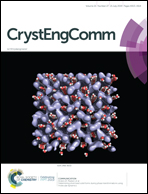Fast growth of high quality AlN films on sapphire using a dislocation filtering layer for ultraviolet light-emitting diodes
Abstract
High quality AlN templates are the foundation of high performance deep-ultraviolet (DUV) optoelectronic devices. Here, we demonstrate a low-cost method to grow high quality AlN films fast on sapphire by metal–organic chemical vapor deposition (MOCVD) without the use of the epitaxial lateral overgrowth (ELOG) or pulse atomic layer epitaxy (PALE) method. During the fast growth process, a dislocation filtering (DF) layer was employed to introduce a large number of AlN islands on the buffer layer, and a recovery layer with a growth rate of 86 nm min−1 was used to ensure the complete coalescence of AlN films. The full width at half maximum (FWHM) of the X-ray rocking curves (XRCs) of the (0002) and (10![[1 with combining macron]](https://www.rsc.org/images/entities/char_0031_0304.gif) 2) planes was reduced from 63/453 to 140/267 arcsec compared with those of the AlN films grown by conventional methods. Benefiting from the improved crystal quality of the AlN template, a DUV-LED grown on AlN with a DF layer showed an increase of the light output power by 40% at 100 mA compared to the reference LED. Our strategy may provide a simple and cost-effective means toward the mass production of high quality AlN films suitable for fabricating high performance DUV devices.
2) planes was reduced from 63/453 to 140/267 arcsec compared with those of the AlN films grown by conventional methods. Benefiting from the improved crystal quality of the AlN template, a DUV-LED grown on AlN with a DF layer showed an increase of the light output power by 40% at 100 mA compared to the reference LED. Our strategy may provide a simple and cost-effective means toward the mass production of high quality AlN films suitable for fabricating high performance DUV devices.



 Please wait while we load your content...
Please wait while we load your content...